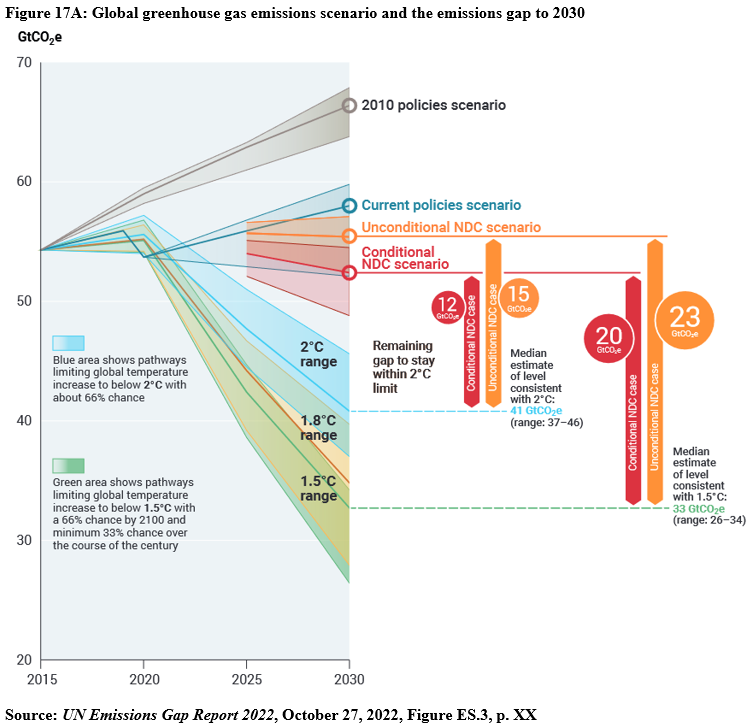Part 17 in a series of 18 discussion papers
Canada’s most recent Emissions Reduction Plan (ERP) published on March 29, 2022, affirms that the aim of Federal Government policy is to continue to maximize our oil production. The government’s plan is clear: Canada’s oil production will continue to increase until – and if – other countries eventually begin to consume less oil. In the meantime, Canada’s production levels will be guided solely by “global demand”. The new UN Emissions Gap Report 2022 published on October 27, 2022, provides a comprehensive picture explaining the extreme danger of our situation.* It includes three crucial findings that define the global scale of the problem:

The annual level of global GHG emissions, not including emissions from changes in land use (i.e., deforestation), reached an estimated 52.8 GtCO2eq in 2021.
The first crucial finding is that with the benefit of all emissions reduction policies currently in place (that means all policies that have already been implemented by all countries and assuming that no additional action is taken) global emissions are projected to increase to 58 GtCO2eq by 2030. That emissions pathway (the “Current policies scenario”) will result in warming of 2.8°C during the twenty-first century. That is the pathway we are presently on.
Second, even with the full implementation of all unconditional NDCs (emissions reduction commitments made by individual countries under the 2015 Paris Agreement, referred to as ‘Nationally Determined Contributions’), global emissions are on track to reach 55 GtCO2eq by 2030. The annual level of global emissions by 2030 will still be higher than it was in 2019, even if all the NDCs promised so far are fully achieved. That level of global emissions by 2030 will put us on a pathway to a temperature increase of 2.6°C above pre-industrial levels. That outcome is depicted by the orange line (the “Unconditional NDC scenario”) shown in Figure 17A.
A third crucial finding set out in the new report is that to stay on a pathway to limit the warming increase to 1.5°C, global emissions must decline to an annual level of 33 GtCO2eq between now and 2030 (far below the projected 55 GtCO2eq, which assumes all the unconditional NDCs so far promised will be fully implemented).
That means we must achieve additional reductions of 23 GtCO2eq all within the next eight years. That is referred to as the “emissions gap” to 1.5°C. Closing the emissions gap would require achieving a 45% reduction of all emissions world-wide within the next eight years.
Canada promises to reduce our domestic emissions 40% by 2030, below the 2005 level. That is our NDC. But even if Canada and all other countries successfully implement and achieve the full amount of their promised unconditional NDC reductions by 2030, that still leaves us on a path to a temperature increase of 2.6°C above pre-industrial levels.
The emissions from Canada’s exported oil are not counted in our domestic emissions
Canada is the world’s 4th largest oil producer and 3rd largest exporter. No amount of further technological improvements in the oil sands industry aimed to “cap” and reduce emissions during extraction activities, not even large-scale adoption of Carbon Capture, Utilization, and Storage (CCUS) technology at oil sands production sites, will significantly lower the total amount of emissions that will be released into the atmosphere from oil sourced from Canada’s oil sands. None of the Federal Government’s declared policies, including plans to subsidize large-scale CCUS deployment in the oil sands industry, are intended to bring about any decline in the currently projected growth of Canada’s oil production. Our predicament is that over 85% of the life-cycle emissions of every barrel of oil we produce occur after the extraction process is completed, after we export our oil, when it is burned as fuel in cars and trucks (“downstream emissions”) and released into the atmosphere as tailpipe emissions.†
The world’s six largest oil producers (including Canada) have no present intention to curb the ongoing increase in their oil production and exports.
Of the total amount of greenhouse gas emissions which reached an estimate 52.8 GtCO2eq in 2021, about 70% of that amount were emissions from burning coal, oil, and natural gas – representing about 36.6 GtCO2. Recent estimates indicate that globally the share of CO2 emissions attributed to coal use is 15.1 GtCO2; another 12.1 GtCO2 is attributed to combustion of oil.; and 7.9 GtCO2 is from the combustion of natural gas.
CO2 emissions from coal, oil, and natural gas use must be reduced by more than one-third within the next eight years – falling from 36.6 to less than 23 GtCO2 by 2030: see World Energy Outlook 2022, section 3.3 at page 125. Coal use has been slowly declining in the richest advanced industrial economies, but natural gas use is rising. Achieving a reduction in overall global emissions cannot be achieved without accelerated cuts in coal production and substantial reductions in both oil and natural gas production, all within the next eight years.
Our predicament is severe. The present pathway that Canada and other major fossil fuel producers have adopted – which is characterized by the continuing growth of oil and natural gas production through the rest of this decade and only a slight decline in coal production – means the world is headed to warming of about 2.6°C.
The terrible risk and burden of catastrophic and irrevocable climate breakdown is being quietly shifted to the world’s children, in exchange for our own immediate financial gain from our expanding Canada’s production.
* UN Emissions Gap Report 2022, October 27, 2022: https://www.unep.org/resources/emissions-gap-report-2022
† Part 8 and Part 9 of this series of papers discuss in more detail the relationship between “upstream emissions” generated during the oil production process within Canada’s borders and the much larger volume of “downstream emissions” that are released into the atmosphere when our exported oil is consumed as fuel in foreign markets, and why CCUS technology is not a solution.